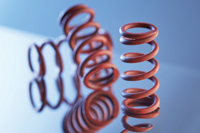
Posted to News on 19th Jul 2018, 00:00
Enhancing spring properties with secondary processes
There are many aspects to consider when specifying compression, tension and torsion springs, but one aspect that is sometimes overlooked is that of secondary processes and finishing. Mark Simms spoke to William Hughes engineering director Emma Burgon.

The humble spring is surely one of the unsung heroes of the engineering world, playing profoundly important roles in so many different industries. With springs responsible for the correct and reliable operation of systems in a huge range of applications, getting the specification wrong can have a critical impact on the end user’s brand reputation and bottom line.
The specification process can be a fine balancing act of form and function, looking at spring formulae and taking into consideration performance requirements, dimensions, tolerances and materials. But environmental considerations are also key, while aesthetics can make a big difference in high value applications. These can be addressed by the choice of material in some applications, but in others secondary processes such as painting, coating and passivation have a key role to play. It is these secondary processes that are sometimes overlooked.
“Take corrosion resistance, for example,” says Emma Burgon, engineering director at William Hughes. “If you’re specifying a spring as the closing mechanism on a gate in a field, then taking galvanised wire and coiling it is most likely going to be fine, giving you the protection you need from the prevailing climatic conditions. On the other hand, if you’re specifying a spring that controls the door on a submarine, then galvanised steel is very far from fine.”
It is worth recapping, then, on the typical secondary processes and finishes that are available to tailor the properties of a spring to its application.
Two key processes are plastic coating and painting, and while a plastic coated spring and a painted spring in the same colour can look superficially similar, they can have very different properties. “Either can give you the aesthetics you require, and sometimes aesthetics is the start and end of the story,” says Burgon. “But there can be more, and it’s important to look at where the component is going to be used.
“Plastic coating, for example, gives you a coating up to 0.5mm thick, and that might be very useful in an application where it is advantageous to have some cushioning between metal components. A good example might be a component inside a car, where you would like to avoid direct metal-on-metal contact.
“But typical plastic coatings such as Nylon PA11 or PA12 are hydroscopic, so they suck in water,” she continues. “In many applications, outside for example, that makes plastic coating a non-ideal solution.” In other applications, the thickness of the plastic coating could interfere with the functioning of the spring.
So what about painting instead? There are a number of options for painting springs, with two of the most popular being electrophoretic painting and delta-tone finishing. “Electrophoretic painting is a very thin coating that can provide an aesthetically very pleasing product finish,” says Burgon.
William Hughes employs a KTL-black electrophoretic process to deposit a coating just a few microns thick on the spring. “Because the coating is so thin, it doesn’t interfere with the functionality of the part, and the shiny black finish is very appealing,” says Burgon. “A lot of automotive components are KTL-black. At the same time it can give you outside protection for up to 800 salt spray hours, which can be enough to meet even some quite challenging environmental requirements.”
High levels of corrosion resistance can also be provided by delta-tone finishing, an organic paint process that is particularly suitable for springs because of its flexible finish and its low curing temperature. “Many springs are stress relieved up to 300°C,” explains Burgon, “so you wouldn’t want to expose them to any heat treatments that are higher than that as it could change the properties of the spring.”
Burgon adds that William Hughes can offer delta-tone finishing in a number of different colours, including red, green, blue, silver and black. This has implications beyond just the aesthetic: “Many springs that look almost identical to the naked eye can have very different properties,” explains Burgon. “If a lot of these are going into the same factory, then colour coding can provide a very useful means of identifying different springs for different applications.”
One process that is not always clearly understood is passivation, which is a chemical treatment rather than the addition of a coating to the spring surface. Primarily a cleaning process, it can have important implications for corrosion resistance. “It’s a finishing process that would typically be applied to stainless steel springs,” explains Burgon. “Of course stainless steel is inherently corrosion resistant, but machining or grinding processes can inadvertently add tiny particles of standard steel to the surface of the spring, which could then rust. Passivation removes those particles to preserve the corrosion resistance of the part.”
Such is the quality of William Hughes’ passivation process that the company has been awarded NADCAP accreditation for the supply of parts to the aerospace industry.
Getting the most appropriate level of corrosion resistance in a given spring application will often be a balancing act between the required performance, the anticipated longevity and/or cost. A galvanised coil might well provide all the corrosion resistance that is needed in one application, while delta-tone finishing might be an essential requirement in another. And frequently there is an overlap in the properties afforded by different finishing processes for a given application, which can further complicate the specification considerations.
Fortunately, spring manufacturers such as William Hughes that can offer a full range of secondary finishing processes are on hand to advise on the most suitable finish for a specific spring application.
















